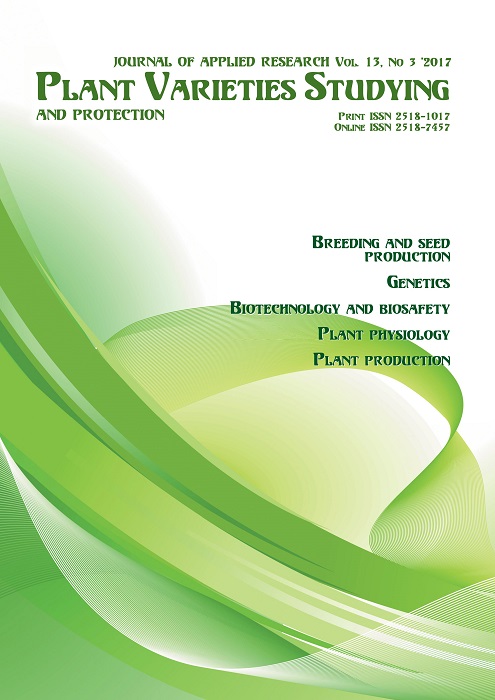Variability of seed quality indices in soft spring wheat depending on weather conditions
DOI:
https://doi.org/10.21498/2518-1017.13.3.2017.110717Keywords:
bread spring wheat, weather conditions, grain quality indicesAbstract
Purpose. To study the effect of weather conditions on grain quality in soft spring wheat lines that are undergoing competitive variety trial. To identify indices to be least affected by weather conditions. To investigate the correlation dependence between grain quality indices in the years with contrasting weather conditions and conduct the analysis of variance.
Methods. Parameters of grain and flour quality of bread spring wheat lines were determined using conventional methods at the laboratory of grain quality of V. M. Remeslo Myronivka Institute of Wheat, NAAS of Ukraine, protein content in flour was measured with the use of the SPECTRAN 119M device.
Results. Contrasting weather conditions were considered including arid ones (2013) – that had negative effect on 1000 kernel weight, but at the same time positively influenced the averaged grain quality indices; with excess humidity (2014) – they resulted in decreasing of all technological indices; optimal ones (2015) – allowed to obtain maximum indices of grain and flour quality. Paired coefficients of correlation between different parameters of grain and flour quality were calculated. The most number of strong and medium correlations was found in a dry year (33.3%), the smallest one – in a wet year (13.0%). Such indices as flour strength, dough dilution and protein content depended on the conditions of the growing year least of all. Grain-unit response was the most considerable to the humid conditions of the year. The analysis of variance showed that climatic conditions had significant effect on the quality indices of grain and flour. At the same time, an important genotypic component was revealed in indices of dough resilience (63%), bread volume and rating (61 and 53% respectively), the flour strength (42%), crude gluten quality (33%), bread porosity (30%). With climate variations, the genotypic conditionality of the content of protein and especially crude gluten was expressed insignificantly.
Conclusions. When creating high quality cultivars, plant breeders should be guided by such indices as flour strength, dough resilience, gluten quality, bread volume and rating as only they are more genetically determined
Downloads
References
Zhemela, H. P., Shemavnov, V. I., Marenych, M. M., & Oleksiuk, O. M. (2005). Tekhnolohiia zberihannia ta pererobky produktsii roslynnytstva [Technology of storage and processing of crop products]. Dnipropetrovsk: N.p. [in Ukrainian]
Bozhko, L. Yu., & Barsukova, O. A. (2010). Ahrometeorolohichni prohnozy. Praktykum [Agrometeorological forecasting. Practical guide]. Odesa: TES. [in Ukrainian]
Retman, M. S. (2011). Quality of spring wheat grain. Karantin i zahist roslin [Quarantine and Plant Protection], 12, 10–12. [in Ukrainian]
Koliuchyi, V. T., & Blokhin, M. I. (2007). Quality of wheat grain. Selektsiia, nasinnytstvo i tekhnolohiia vyroshchuvannia zernovykh kolosovykh kultur u Lisostepu Ukrainy [Breeding, seed production and spiked cereals cultivation technology in the Forest-Steppe zone of Ukraine]. Kyiv: Ahrarna nauka. [in Ukrainian]
Derhachov, O. L. (2010). Influence of sowing time and mineral feeding backgrounds on baking quality of winter wheat grain. Naukovo-tekhnichnyi biuleten MIP imeni V. M. Remesla [Scientific and technical bulletin of V. M. Remeslo Myronivka Institute of Wheat], 10, 247–253. [in Ukrainian]
Derhachov, O. L. (2010). Produktyvnist sortiv pshenytsi miakoi ozymoi zalezhno vid strokiv ta foniv mineralnoho zhyvlennia v Pravoberezhnomu Lisostepu Ukrainy [Productivity of soft winter wheat varieties depending on time and backgrounds of mineral feeding in the Right-Bank Forest-Steppe zone of Ukraine]. (Extended Abstract of Cand. Agric. Sci. Diss.). National University of Life and Environmental Sciences of Ukraine, Kyiv, Ukraine. [in Ukrainian]
Siroshtan, A. A. (2012). Udoskonalennia elementiv systemy nasinnytstva pshenytsi ozymoi shliakhom optymizatsii ahrotekhnichnykh pryiomiv v umovakh Pravoberezhnoho Lisostepu Ukrainy [Improvement of elements of the system of winter wheat seed production by cultivation methods optimization under the conditions of the Right-Bank Forest-Steppe zone of Ukraine] (Extended Abstract of Cand. Agric. Sci. Diss.). NSC “Institute of Agriculture NAAS”, Kyiv, Ukraine. [in Ukrainian]
Filippova, E. A., Mal’tseva, L. T., Bannikova, N. Yu., & Efimova, A. G. (2011). Influence of natural factors on a vegetation period, productivity and quality of soft winter wheat varieties. Agrar. vestn. Urala [Agrarian Bulletin of the Urals], 4, 6–9. [in Russia]
Tkachyk, S. O. (Eds). (2015). Metodyka derzhavnoyi naukovo-tekhnichnoyi ekspertyzy sortiv roslyn. Metody vyznachennya pokaznykiv yakosti produktsiyi roslynnytstva [Regulations on the procedure and conduct of state research and technology test of plant varieties. Methods of determination of indices of crop production quality]. (4th ed., rev.). Vinnytsia: Nilan-LTD. [in Ukrainian]
Downloads
Published
How to Cite
Issue
Section
License
Copyright (c) 2017 Ukrainian Institute for Plant Variety Examination

This work is licensed under a Creative Commons Attribution-ShareAlike 4.0 International License.
Starting in 2022, the copyright to the publication remains with the authors
Our journal abides by the CREATIVE COMMONS copyright rights and permissions for open access journals.
Authors, who are published in this journal, agree to the following conditions:
- The authors reserve the right to authorship of the work and pass the first publication right of this work to the journal under the terms of a Creative Commons Attribution License, which allows others to freely distribute the published research with the obligatory reference to the authors of the original work and the first publication of the work in this journal.
- The authors have the right to conclude separate supplement agreements that relate to non-exclusive work distribution in the form in which it has been published by the journal (for example, to upload the work to the online storage of the journal or publish it as part of a monograph), provided that the reference to the first publication of the work in this journal is included.

























 Ukrainian Institute for Plant Varieties Examination
Ukrainian Institute for Plant Varieties Examination  Селекційно-генетичний інститут
Селекційно-генетичний інститут Institute of Plant Physiology and Genetics of the National Academy of Sciences of Ukraine
Institute of Plant Physiology and Genetics of the National Academy of Sciences of Ukraine
 The National Academy of Agrarian Sciences of Ukraine
The National Academy of Agrarian Sciences of Ukraine